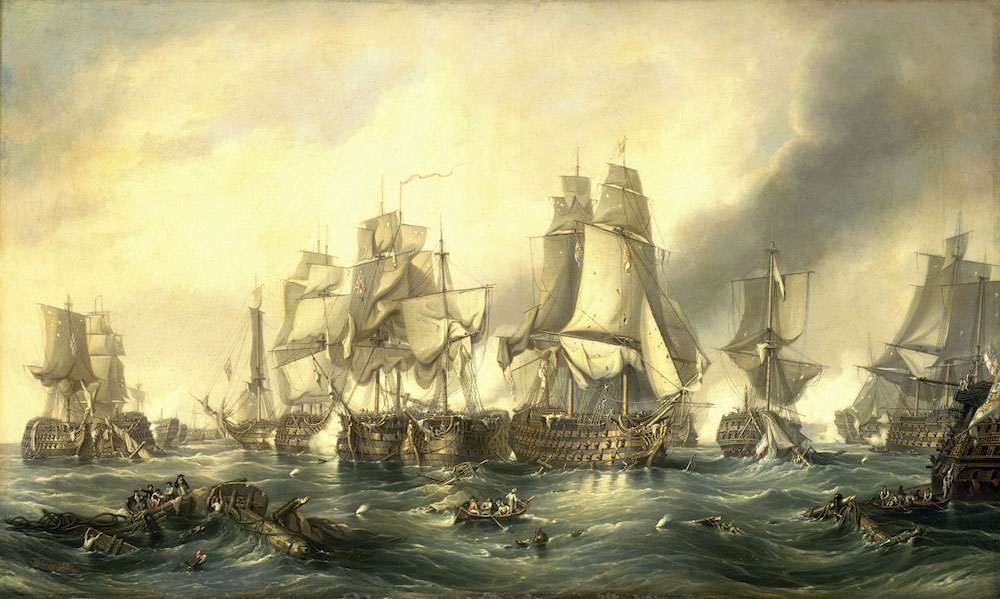
The Battle of Trafalgar, 21 October 1805: Death of Nelson. c.1836. Oil on canvas. H 73.5 x W 120.5 cm. Collection and photo credit: National Maritime Museum, Greenwich, London. Accession no. BHC0545. [Click on both images to enlarge them.]

Battle of Trafalgar by Clarkson Stanfield — engraving of the original oil sketch. J. Cousen, engraver. 1836. The Art-Journal. The difference in composition from the final work is quite pronounced: as the The Art-Journal critic says, for example, the artist decided to fill "in his canvas rather more to the right."
Commentary in the The Art-Journal
It is altogether needless, at this date, to eulogise Mr. Stanfield as a painter of marine subjects; he is the Van der Velde of the English school in the truth and fidelity of his representations, while his pictures exhibit greater brilliancy and more vigour than those of the celebrated Dutch painter. The work here engraved is the original sketch in oils, from which the artist painted his large picture, for the Senior United Service Club, which was exhibited at the Royal Academy in 1836. This great work is one of the finest productions of Mr. Stanfield: the main features of the sketch have been closely followed, but he has altered a little the bearing of two or three of the vessels; and, if wc recollect rightly, has filled in his canvas rather more to the right in the larger picture.
The scene represents the centre of the combined
fleet, at half-past two o'clock, about an hour and a
half after Lord Nelson received his death-wound.
The Victory, the ship which bore his lordship's
flag, after sustaining a heavy fire from four of the
enemy's vessels, is in the act of disengaging herself
from the Redoubtable, a French seventy-four, at
that time lashed alongside the Temiraire, a British
ninety-eipht, and at the moment the Fougueux,
another French seventy-four, became the prize of
the latter. On the left of the spectator is Lord
Collingwood's ship, the Royal Sovereign, with her
prize, the Santa Anna, totally demasted, and the
other ships of the lee division. On the right of
the Victory is the Bucentaure, a French eighty
gun ship, commanded by Admiral Villeneuve, with
her main and mizen masts shot away; and the
Santissima Trinidad, a Spanish four-decker; both
ships unmanageable wrecks from the heavy raking
fire of the Victory, Neptune, Leviathan, &c.
The composition of this sketch is most spirited;
the battle is described with the animation of one
who is not unacquainted with the perils of naval
warfare; while the painter's hand and eye have
marked it with a breadth of effect and a display of
artistic science that cannot be surpassed. But, excellent
as it is, we would rather have seen hanging
in its place the noble picture which succeeded it,
and which, as now located, is visible only to a
few; such a work ought to be national property.
![]()
Image capture and formatting by George P. Landow and Jacqueline Banerjee. [You may use these images for any non-commercial scholarly or educational purpose as long as you (1) check first with the National Maritime Museum, Greenwich, London for the top one, or (for the lower one) credit the Hathi Trust Digital Library and the University of Michigan and (2) link your document to this URL in a web document or cite the Victorian Web in a print one.
Bibliography
“The Vernon Gallery: The Battle of Trafalgar.” Art Journal (1851): 287. HathiTrust Digital Library version of a copy in the University of Michigan Library. Web. 28 July 2013.
Last modified 2 August 2013